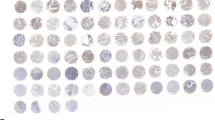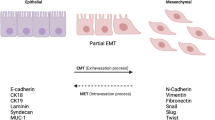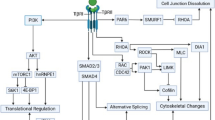Abstract
Pancreatic carcinoma is one of the most malignant and aggressive cancers. Increased motility and invasiveness of pancreatic cancer cells are believed to be associated with epithelial-to-mesenchymal transition (EMT). However, the molecular basis of EMT in pancreatic cancer cells is poorly understood. In this study, we examined the relationship between Jun dimerization protein 2 (JDP2), which is an AP-1 inhibitor, and EMT in human pancreatic carcinoma cells. We demonstrated that transforming growth factor-β1 (TGF-β1) promoted epidermal growth factor (EGF)-induced EMT in co-treated human pancreatic BxPC3 cells and that JDP2 overexpression reversed the EMT that was induced by co-treatment with TGF-β1 and EGF. These results suggest that EGF plays a principal role in EMT through its association with TGF-β1 in human pancreatic BxPC3 cells and that JDP2 may be a molecular target for pancreatic carcinoma intervention.







Similar content being viewed by others
References
Jemal A, Siegel R, Ward E, et al. Cancer statistics. CA Cancer J Clin. 2006;56:106–30.
Huang TC, Kar S, Javle M. Personalized therapy for pancreatic cancer: myth or reality in 2010? J Gastrointest Oncol. 2010;1:24–33.
Kotowski A, Ma WW. Emerging therapies in pancreas cancer. J Gastrointest Oncol. 2011;2:93–103.
Xiao DK, He JX. Epithelial mesenchymal transition and lung cancer. J Thorac Dis. 2010;2:154–9.
Thiery JP. Epithelial–mesenchymal transitions in tumour progression. Nat Rev Cancer. 2002;2:442–54.
Kang Y, Massagué J. Epithelial–mesenchymal transitions: twist in development and metastasis. Cell. 2004;118:277–9.
Xie L, Law BK, Chytil AM, et al. Activation of the Erk pathway is required for TGF-beta1-induced EMT in vitro. Neoplasia (New York). 2004;6:603–10.
Davies M, Robinson M, Smith E, et al. Induction of an epithelial to mesenchymal transition in human immortal and malignant keratinocytes by TGF-beta1 involves MAPK, Smad and AP-1 signalling pathways. J Cell Biochem. 2005;95:918–31.
Aronheim A, Zandi E, Hennemann H, et al. Isolation of an AP-1 repressor by a novel method for detecting protein–protein interactions. Mol Cell Biol. 1997;17:3094–102.
Jin C, Ugai H, Song J, et al. Identification of mouse Jun dimerization protein 2 as a novel repressor of ATF-2. FEBS Lett. 2001;489:34–41.
Kimura M. IRF2-binding protein-1 is a JDP2 ubiquitin ligase and an inhibitor of ATF2-dependent transcription. FEBS Lett. 2008;7:317–24.
Ostrovsky O, Bengal E, Aronheim A. Induction of terminal differentiation by the c-Jun dimerization protein JDP2 in C2 myoblasts and rhabdomyosarcoma cells. J Biol Chem. 2002;277:40043–54.
Piu F, Aronheim A, Katz S, et al. AP-1 repressor protein JDP-2: inhibition of UV-mediated apoptosis through p53 down-regulation. Mol Cell Biol. 2001;21:3012–24.
Bitton-Worms K, Pikarsky E, Aronheim A. The AP-1 repressor protein, JDP2, potentiates hepatocellular carcinoma in mice. Mol Cancer. 2010;9:54.
Nakade K, Pan J, Yamasaki T, et al. JDP2 (Jun dimerization protein 2)-deficient mouse embryonic fibroblasts are resistant to replicative senescence. J Biol Chem. 2009;284:10808–17.
Jin C, Kato K, Chimura T, et al. Regulation of histone acetylation and nucleosome assembly by transcription factor JDP2. Nat Struct Mol Biol. 2006;13:331–8.
Nishioka R, Itoh S, Gui T, et al. SNAIL induces epithelial-to-mesenchymal transition in a human pancreatic cancer cell line (BxPC3) and promotes distant metastasis and invasiveness in vivo. Exp Mol Pathol. 2010;89:149–57.
Cho SG, Yi Z, Pang X, et al. Kisspeptin-10, a KISS1-derived decapeptide, inhibits tumor angiogenesis by suppressing Sp1-mediated VEGF expression and FAK/Rho GTPase activation. Cancer Res. 2009;69:7062–70.
Ellenrieder V, Hendler SF, Boeck W, et al. Transforming growth factor beta1 treatment leads to an epithelial–mesenchymal transdifferentiation of pancreatic cancer cells requiring extracellular signal-regulated kinase 2 activation. Cancer Res. 2001;61:4222–8.
Heinrich R, Livne E, Ben-Izhak O, et al. The c-Jun dimerization protein 2 inhibits cell transformation and acts as a tumor suppressor gene. J Biol Chem. 2004;279:5708–15.
Jin C, Li H, Murata T, et al. JDP2, a repressor of AP-1, recruits an HDAC3 complex to inhibit the retinoic acid-induced differentiation of F9 cells. Mol Cell Biol. 2006;22:4815–26.
Weiss G, Rasmussen S, Nielsen Fink L. Bifidobacterium bifidum actively changes the gene expression profile induced by Lactobacillus acidophilus in murine dendritic cells. PLoS One. 2010;5:e11065.
Wang P, Chen Z, Meng Z, et al. Dual role of Ski in pancreatic cancer cells: tumor-promoting versus metastasis-suppressive function. Carcinogenesis. 2009;30:1497–506.
Yasutome M, Gunn J, Korc M. Restoration of Smad4 in BxPC3 pancreatic cancer cells attenuates proliferation without altering angiogenesis. Clin Exp Metastasis. 2005;22:461–73.
Shintani Y, Hollingsworth MA, Wheelock MJ. Collagen I promotes metastasis in pancreatic cancer by activating c-Jun NH2-terminal kinase 1 and up-regulating N-cadherin expression. Cancer Res. 2006;66:11745–53.
Pan J, Yang M. The role of epithelial–mesenchymal transition in pancreatic cancer. J Gastrointest Oncol. 2011;2:151–6.
Thiery JP, Acloque H, Huang RY. Epithelial–mesenchymal transitions in development and disease. Cell. 2009;139:871–90.
Hsueh C. Pancreatic cancer: current standards, research updates and future directions. J Gastrointest Oncol. 2011;2:123–5.
Kikuta K, Masamune A, Watanabe T. Pancreatic stellate cells promote epithelial–mesenchymal transition in pancreatic cancer cells. Biochem Biophys Res Commun. 2010;403:380–4.
Onoue T, Uchida D, Begum NM. Epithelial–mesenchymal transition induced by the stromal cell-derived factor-1/CXCR4 system in oral squamous cell carcinoma cells. Int J Oncol. 2006;29:1133–8.
Yuanhong X, Feng X, Qingchang L, et al. Downregulation of AP-1 repressor JDP2 is associated with tumor metastasis and poor prognosis in patients with pancreatic carcinoma. Int J Biol Markers. 2010;25:136–40.
Lerdrup M, Holmberg C, Dietrich N, et al. Depletion of the AP-1 repressor JDP2 induces cell death similar to apoptosis. Biochim Biophys Acta. 2005;1745:29–37.
Pan J, Nakade K, Huang YC, et al. Suppression of cell-cycle progression by Jun dimerization protein-2 (JDP2) involves downregulation of cyclin-A2. Oncogene. 2010;29:6245–56.
Benbrook DM, Jones NC. Heterodimer formation between CREB and JUN proteins. Oncogene. 1990;5:295–302.
Jensen K, Afroze S, Munshi MK, et al. Mechanisms for nicotine in the development and progression of gastrointestinal cancers. Transl Gastrointest Cancer. 2012;1:81–7.
Berger AJ, Kluger HM, Li N, Kielhorn E, Halaban R, et al. Subcellular localization of activating transcription factor 2 in melanoma specimens predicts patient survival. Cancer Res. 2003;63:8103–7.
Lee SH, Bahn JH, Whitlock NC, Baek SJ. Activating transcription factor 2 (ATF2) controls tolfenamic acid-induced ATF3 expression via MAP kinase pathways. Oncogene. 2010;29(37):5182–92.
Conflicts of interest
None.
Author information
Authors and Affiliations
Corresponding authors
Rights and permissions
About this article
Cite this article
Liu, Z., Du, R., Long, J. et al. JDP2 inhibits the epithelial-to-mesenchymal transition in pancreatic cancer BxPC3 cells. Tumor Biol. 33, 1527–1534 (2012). https://doi.org/10.1007/s13277-012-0404-5
Received:
Accepted:
Published:
Issue Date:
DOI: https://doi.org/10.1007/s13277-012-0404-5




